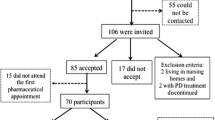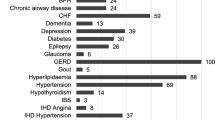Abstract
Background The well-being of patients with Parkinson’s disease may be improved by pharmaceutical care in community pharmacies. Objective To investigate the effects of standardised pharmaceutical care on health outcomes and quality of drug treatment in patients with Parkinson’s disease. Setting Community pharmacies in Germany. Method An open-label, multicentre, longitudinal, parallel-group study was conducted in outpatients with idiopathic Parkinson’s disease who were receiving anti-parkinsonian medication. Patients were recruited by 32 community pharmacists (pharmacy group) and local offices of the German Parkinson’s disease patients’ association (comparison group). All patients were assessed at baseline and at 8 months’ follow-up. In the intervening period, the pharmacists provided patients in the pharmacy group with standardised pharmaceutical care. Main outcome measure Mean change in symptom-related impairment of health status, assessed using the 23-item Parkinson’s Scale Total Score. Results In total 235 patients were enrolled into the study (113 pharmacy group; 122 comparison group). Between-group analysis showed that the mean changes in the primary and secondary endpoints, all 23-item Parkinson’s Scale sub-scores and the EuroQol 5-Dimension Questionnaire Index Score were significantly in favour of the pharmacy group after 8 months (p < 0.05 to p < 0.001), using a mixed model analysis. No significant changes were observed in prescribers’ guideline adherence, but there was a significant decrease in the proportion of patients receiving inappropriate drugs according to the Beers List in the pharmacy group (p < 0.01). Conclusion This study shows that significant benefits in patient health outcomes and age-related quality of drug treatment were gained when patients with Parkinson’s disease were provided with standardised pharmaceutical care in community pharmacies.

Similar content being viewed by others
References
Eggert K, Deuschl G, Gasser T, Oertel WH, Arnold G, Baas H, et al. Leitlinie Parkinson-Syndrome, 2. Ausgabe. In: Leitlinien für Diagnostik und Therapie in der Neurologie. 3. überarbeitete Auflage. [Parkinson’s disease guideline. 2nd edn. In: Guidelines for diagnosis and therapy in neurology. 3rd revised edn.]. Stuttgart: Georg Thieme Verlag; 2005, ISBN:[3-13-132413-9]. In German.
Visser M, Verbaan D, van Rooden S, Marinus J, van Hilten J, Stiggelbout A. A longitudinal evaluation of health-related quality of life of patients with Parkinson’s disease. Value Health. 2009;12(2):392–6.
Chrischilles EA, Rubenstein LM, Voelker MD, Wallace RB, Rodnitzky RL. Linking clinical variables to health-related quality of life in Parkinson’s disease. Parkinsonism Relat Disord. 2002;8(3):199–209.
Schrag A, Ben-Shlomo Y, Quinn N. How common are complications of Parkinson’s disease? J Neurol. 2002;249(4):419–23.
Rascol O, Payoux P, Ory F, Ferreira JJ, Brefel-Courbon C, Montastruc JL. Limitations of current Parkinson’s disease therapy. Ann Neurol. 2003;53 Suppl 3:S3–S12; discussion S12–5.
Leoni O, Martignoni E, Cosentino M, Michielotto D, Calandrella D, Zangaglia R, et al. Drug prescribing patterns in Parkinson’s disease: a pharmacoepidemiological survey in a cohort of ambulatory patients. Pharmacoepidemiol Drug Saf. 2002;11(2):149–57.
Schröder S, Zöllner YF, Schaefer M. Drug related problems with Antiparkinsonian agents: consumer Internet reports versus published data. Pharmacoepidemiol Drug Saf. 2007;16(10):1161–6.
Hepler CD, Strand LM. Opportunities and responsibilities in pharmaceutical care. Am J Hosp Pharm. 1990;47(3):533–43.
van Mil JWF, Schulz M. A review of pharmaceutical care in community pharmacy in Europe. Harv Health Policy Rev. 2006;7(1):155–68.
Nkansah N, Mostovetsky O, Yu C, Chheng T, Beney J, Bond CM, et al. Effect of outpatient pharmacists’ non-dispensing roles on patient outcomes and prescribing patterns. Cochrane Database Syst Rev. 2010;7.
Mynors G, Jenkinson C, MacNeill V, Balcon R. A pilot evaluation of specialist community pharmacy services for patients with Parkinson’s disease. Pharm J. 2007;278(7456):709–12.
Schaefer M, Schulz M. Manuale zur Pharmazeutischen Betreuung—Band 1: Grundlagen der Pharmazeutischen Betreuung [Manuals on pharmaceutical care—volume 1: foundations of pharmaceutical care]. Govi-Verlag; 2000. ISBN:978-3-7741-0844-8. In German.
Barmer Ersatzkasse (BEK), Deutschen Apothekerverband e.V. (DAV). Vereinbarung zwischen der Barmer Ersatzkasse (BEK) und dem Deutschen Apothekerverband e.V. (DAV) zur Intensivierung der Kooperation bei der qualitätsorientierten Versorgung der Versicherten [Agreement between Barmer Ersatzkasse (BEK) and the German Pharmacists’ Association (DAV) to intensify cooperation in the quality-oriented care of insured patients]. 2004. In German.
Schröder S, Martus P, Odin P, Schaefer M. Drug-related problems in Parkinson’s disease: the role of community pharmacists in primary care. Int J Clin Pharm. 2011;33(4):674–82.
Hughes AJ, Daniel SE, Kilford L, Lees AJ. Accuracy of clinical diagnosis of idiopathic Parkinson’s disease: a clinico-pathological study of 100 cases. J Neurol Neurosurg Psychiatry. 1992;55(3):181–4.
World Medical Association (WMA). Declaration of Helsinki. Ethical principles for medical research involving human subjects. 52nd WMA General Assembly, Edinburgh, Scotland, Oct 2000 (updated at 53rd WMA General Assembly, Washington, DC, USA, Oct 2002).
Apothekenbetriebsordnung (ApBetrO). Verordnung über den Betrieb von Apotheken [Ordinance on the operation of pharmacies]. BGBl. 1995;51:1195; amended in BGBI. 2005;34:1645. In German.
Arzneimittelgesetz (AMG). Gesetz über den Verkehr mit Arzneimitteln [Law on the marketing of drugs]. BGBl. 2005;73:3394. In German.
Hoehn MM, Yahr MD. Parkinsonism: onset, progression and mortality. Neurology. 1967;17(5):427–42.
Martus P. Entwicklung einfacher Scores für Dimensionen der Symptomschwere bei Morbus Parkinson auf Basis der Faktorscores des PS-23 Fragebogeninstruments [Development of simple scores for dimensions of symptom severity in Parkinson’s disease based on the factor scores of the PS-23 questionnaire instrument]. Technical report from the Charité Centrum für Therapieforschung [report on the internet]. 2010. Cited June 2012. Available from: http://www.medizin.uni-tuebingen.de/uktmedia/Einrichtungen/Institute/Institut+fuer+Medizinische+Biometrie/PDF_Archiv/Martus+report+PS_23.pdf. In German.
Jenkinson C, Fitzpatrick R, Peto V, Greenhall R, Hyman N. The PDQ-8: development and validation of a short-form Parkinson’s disease questionnaire. Psychol Health. 1997;12(6):805–14.
The EuroQol Group. EuroQol—a new facility for the measurement of health-related quality of life. Health Policy. 1990;16(3):199–208.
Brooks R, Rabin R, de Charro F. The measurement and valuation of health status using EQ-5D: a European perspective. Boston: Kluwer Academic Publishers; 2003. p. 324. ISBN:1-4020-1214-4.
Schwalbe O, Freiberg I, Kloft C. Die Beers-Liste: Ein Instrument zur Optimierung der Arzneimitteltherapie geriatrischer Patienten [The Beers criteria: an instrument to optimise the pharmacotherapy of geriatric patients]. Med Monatsschr Pharm. 2007;30(7):244–8.
Beers MH, Ouslander JG, Rollingher I, Reuben DB, Brooks J, Beck JC. Explicit criteria for determining inappropriate medication use in nursing home residents. UCLA Division of Geriatric Medicine. Arch Intern Med. 1991;151(9):1825–32.
Schröder S, Kuessner D, Arnold G, Zöllner Y, Jones E, Schaefer M. Do neurologists in Germany adhere to the national Parkinson’s disease guideline? Neuropsychiatr Dis Treat. 2011;7:103–10.
Liang MH, Fossel AH, Larson MG. Comparisons of five health status instruments for orthopedic evaluation. Med Care. 1990;28(7):632–42.
Chaudhuri KR, Martinez-Martin P, Schapira AH, Stocchi F, Sethi K, Odin P, et al. International multicenter pilot study of the first comprehensive self-completed nonmotor symptoms questionnaire for Parkinson’s disease: the NMSQuest study. Mov Disord. 2006;21(7):916–23.
Lee MA, Prentice WM, Hildreth AJ, Walker RW. Measuring symptom load in idiopathic Parkinson’s disease. Parkinsonism Relat Disord. 2007;13(5):284–9.
Roughead EE, Semple SJ, Vitry AI. Pharmaceutical care services: a systematic review of published studies, 1990 to 2003, examining effectiveness in improving patient outcomes. Int J Pharm Pract. 2005;13(1):53–70.
Scottish Intercollegiate Guidelines Network (SIGN). SIGN 50: a guideline developer’s handbook [book on the internet]. 2008. Cited Oct 2011. Available from: http://www.sign.ac.uk/guidelines/fulltext/50/annexb.html.
Machado M, Bajcar J, Guzzo GC, Einarson TR. Sensitivity of patient outcomes to pharmacist interventions. Part I: systematic review and meta-analysis in diabetes management. Ann Pharmacother. 2007;41(10):1569–78.
Machado M, Nassor N, Bajcar JM, Guzzo GC, Einarson TR. Sensitivity of patient outcomes to pharmacist interventions. Part III: systematic review and meta-analysis in hyperlipidemia management. Ann Pharmacother. 2008;42(9):1195–207.
Dowding CH, Shenton CL, Salek SS. A review of the health-related quality of life and economic impact of Parkinson’s disease. Drugs Aging. 2006;23(9):693–721.
Harrison JE, Preston S, Blunt SB. Measuring symptom change in patients with Parkinson’s disease. Age Ageing. 2000;29(1):41–5.
Reuther M, Spottke EA, Klotsche J, Riedel O, Peter H, Berger K, et al. Assessing health-related quality of life in patients with Parkinson’s disease in a prospective longitudinal study. Parkinsonism Relat Disord. 2007;13(2):108–14.
Schrag A, Spottke A, Quinn NP, Dodel R. Comparative responsiveness of Parkinson’s disease scales to change over time. Mov Disord. 2009;24(6):813–8.
Luo N, Ng WY, Lau PN, Au WL, Tan LC. Responsiveness of the EQ-5D and 8-item Parkinson’s Disease Questionnaire (PDQ-8) in a 4-year follow-up study. Qual Life Res. 2010;19(4):565–9.
Kheir NM, van Mil JW, Shaw JP, Sheridan JL. Health-related quality of life measurement in pharmaceutical care. Targeting an outcome that matters. Pharm World Sci. 2004;26(3):125–8.
Jano E, Aparasu RR. Healthcare outcomes associated with beers’ criteria: a systematic review. Ann Pharmacother. 2007;41(3):438–47.
Al-Momany NH, Al-Bakri AG, Makahleh ZM, Wazaify MM. Adherence to international antimicrobial prophylaxis guidelines in cardiac surgery: a Jordanian study demonstrates need for quality improvement. J Manag Care Pharm. 2009;15(3):262–71.
Bond CM, Fish A, Porteous TH, Reid JP, Scott A, Antonazzo E. A randomised controlled trial of the effects of note-based medication review by community pharmacists on prescribing of cardiovascular drugs in general practice. Int J Pharm Pract. 2007;15(1):39–46.
Acknowledgments
The authors would like to thank: the study pharmacists for participation in the study; the German PD patients’ association (Deutsche Parkinson Vereinigung e.V., Bundesverband); the patients, treating neurologists and physicians for their collaboration in the study; and Vicky Hinstridge and Chris Watling for their assistance in editing the final manuscript.
Funding
The study was supported by an unrestricted grant from Solvay Pharmaceuticals GmbH, Hanover, Germany.
Conflicts of interest
None of the authors has any relevant conflict.
Author information
Authors and Affiliations
Corresponding author
Rights and permissions
About this article
Cite this article
Schröder, S., Martus, P., Odin, P. et al. Impact of community pharmaceutical care on patient health and quality of drug treatment in Parkinson’s disease. Int J Clin Pharm 34, 746–756 (2012). https://doi.org/10.1007/s11096-012-9672-9
Received:
Accepted:
Published:
Issue Date:
DOI: https://doi.org/10.1007/s11096-012-9672-9




